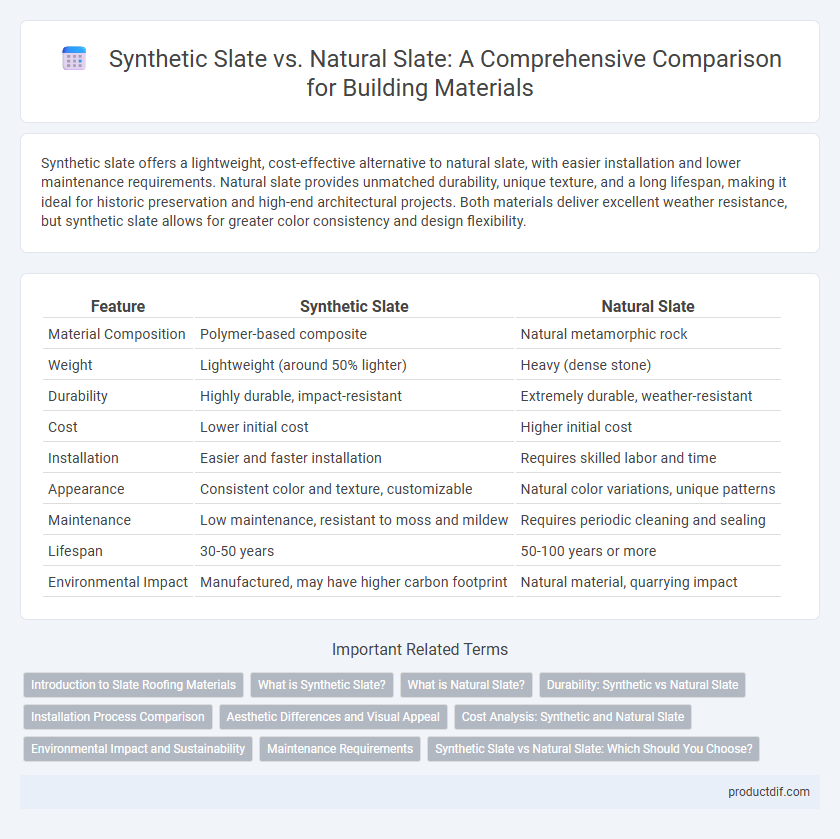Synthetic slate offers a lightweight, cost-effective alternative to natural slate, with easier installation and lower maintenance requirements. Natural slate provides unmatched durability, unique texture, and a long lifespan, making it ideal for historic preservation and high-end architectural projects. Both materials deliver excellent weather resistance, but synthetic slate allows for greater color consistency and design flexibility.
Table of Comparison
| Feature | Synthetic Slate | Natural Slate |
|---|---|---|
| Material Composition | Polymer-based composite | Natural metamorphic rock |
| Weight | Lightweight (around 50% lighter) | Heavy (dense stone) |
| Durability | Highly durable, impact-resistant | Extremely durable, weather-resistant |
| Cost | Lower initial cost | Higher initial cost |
| Installation | Easier and faster installation | Requires skilled labor and time |
| Appearance | Consistent color and texture, customizable | Natural color variations, unique patterns |
| Maintenance | Low maintenance, resistant to moss and mildew | Requires periodic cleaning and sealing |
| Lifespan | 30-50 years | 50-100 years or more |
| Environmental Impact | Manufactured, may have higher carbon footprint | Natural material, quarrying impact |
Introduction to Slate Roofing Materials
Slate roofing materials offer durability and aesthetic appeal, with synthetic slate providing lightweight, cost-effective alternatives that mimic the natural stone's texture and color. Natural slate is prized for its long lifespan, fire resistance, and authentic appearance, often lasting over a century with minimal maintenance. Synthetic slate, made from rubber or polymer composites, delivers easier installation and enhanced weather resistance, making it a practical choice for modern construction.
What is Synthetic Slate?
Synthetic slate is an engineered roofing material designed to mimic the appearance and texture of natural slate while offering enhanced durability and lower weight. Manufactured from rubber, plastic, or a combination of recycled materials, synthetic slate provides resistance to cracking, fading, and moisture absorption, making it suitable for diverse climates. Its installation process is often faster and less labor-intensive compared to natural slate, reducing overall construction costs without compromising aesthetic appeal.
What is Natural Slate?
Natural slate is a durable, metamorphic rock formed from shale subjected to intense heat and pressure over millions of years, commonly used for roofing, flooring, and wall cladding. It offers unique variations in color, texture, and thickness due to its natural composition, providing a distinctive aesthetic that synthetic alternatives often lack. Resistant to weathering, fire, and frost, natural slate is valued for its longevity and minimal maintenance in construction projects.
Durability: Synthetic vs Natural Slate
Synthetic slate offers enhanced durability through resistance to impact, weathering, and UV degradation, maintaining its appearance and structural integrity over time. Natural slate, while highly durable and able to withstand harsh environmental conditions, is prone to cracking and chipping due to its natural fissility and brittleness. The longevity of synthetic slate often exceeds that of natural slate, with lower maintenance requirements and increased resilience against freeze-thaw cycles.
Installation Process Comparison
Synthetic slate offers a lightweight alternative to natural slate, simplifying the installation process by reducing the need for additional structural support. Unlike natural slate, which requires skilled labor and careful handling due to its brittleness and weight, synthetic slate panels can be installed more quickly using standard roofing tools. This efficiency in installation minimizes labor costs and project timelines while maintaining durability and aesthetic appeal.
Aesthetic Differences and Visual Appeal
Synthetic slate offers consistent color and uniform texture, providing a sleek and modern appearance that suits contemporary architectural styles. Natural slate features unique variations in color, veining, and texture, creating a rich, timeless aesthetic that enhances the character of traditional buildings. Both materials deliver striking visual appeal, with synthetic slate appealing to those seeking uniformity and natural slate preferred for its authentic, organic beauty.
Cost Analysis: Synthetic and Natural Slate
Synthetic slate typically costs between $3 to $5 per square foot, offering a budget-friendly alternative to natural slate, which ranges from $6 to $15 per square foot depending on quality and origin. Installation expenses for synthetic slate are generally lower due to its lighter weight and easier cutting process, reducing labor time and fees compared to natural slate. Long-term maintenance costs favor synthetic slate as it resists cracking and requires less upkeep, whereas natural slate may incur higher repair and replacement expenses over time.
Environmental Impact and Sustainability
Synthetic slate offers a significantly lower environmental impact compared to natural slate by utilizing recyclable materials and requiring less energy-intensive manufacturing processes. Natural slate, while durable and long-lasting, involves quarrying that disrupts ecosystems, generates substantial waste, and emits higher carbon footprints during extraction and transportation. Choosing synthetic slate supports sustainability through reduced resource depletion and enhanced recyclability in roofing applications.
Maintenance Requirements
Synthetic slate requires significantly less maintenance compared to natural slate due to its durability and resistance to cracking, chipping, and fading. Natural slate demands routine inspections, cleaning, and sealing to prevent moss growth, water infiltration, and structural damage. Choosing synthetic slate reduces long-term upkeep costs and labor associated with preserving the roof's aesthetic and functional properties.
Synthetic Slate vs Natural Slate: Which Should You Choose?
Synthetic slate offers consistent color, uniform size, and enhanced durability compared to natural slate, making it a cost-effective option with easier installation and lower maintenance requirements. Natural slate, prized for its unique, natural texture and superior longevity, often commands a higher price and requires skilled labor for installation. Choosing between synthetic and natural slate depends on budget constraints, desired aesthetic, and long-term performance needs for roofing or cladding projects.
Synthetic Slate vs Natural Slate Infographic

 productdif.com
productdif.com